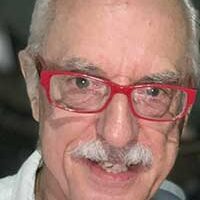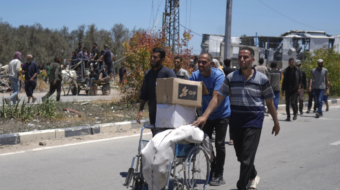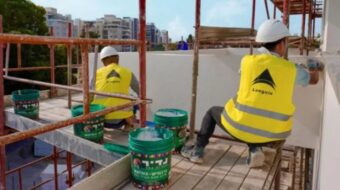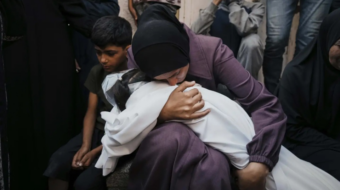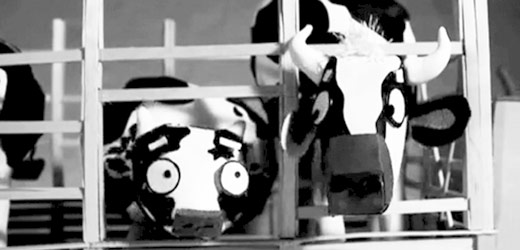
There’s never been a film about Palestine quite like The Wanted 18, a charmingly subversive human comedy that had its world premiere at the 2014 Toronto International Film Festival. Combining stop-motion animation, drawings, live interviews and reenacted scenes, while blending Palestinian and Canadian esthetics, this highly creative documentary succeeds on many levels.
During the first Intifada, now seemingly eons ago, creative attempts were made to overcome the harsh realities of the Occupation. A group of people in Beit Sahour, a small village in the West Bank, gathered donations to buy several cows from a left-wing kibbutz, in order to produce their own milk on a collective farm. Because this cut into Israeli profits, the 18 “illegal” cows were declared a “threat to the national security of the state of Israel,” and a massive search was on.
The experience is remembered by many of the townspeople involved, a doctor, pharmacist, butcher, and many others who had never seen a cow before, resulting in some hilarious stories. When they were bringing the cows to the village, at night in a truck in a rainstorm, they went up a hill, got stuck, and the cows escaped out the back, running into the dark every which way throughout the village. It took a long time to round them up, and once they did, they realized no one knew how to milk a cow. And it gets more hilarious! The clever stop-action animation that alternates with live-action footage humanizes the cows by letting them talk and express their feelings. They are supposedly Jewish cows, now taken to a strange Arab land, and their comments reflect off the social conditions of the Occupation.
Co-directors Amer Shomali and Paul Cowan spoke with me discussing the challenges of artistic collaboration and the application of art in humanizing the struggle. Amer was born in Kuwait, but his family came from Beit Sahour in Palestine. They were kicked out of Kuwait and forced into a Syrian refugee camp. In 1990, Amer read a story about Beit Sahour in a comic book called “The Young Arab.” It was about checkpoints, the Intifada, and an intriguing story about how cows were used in the struggle. He started fantasizing about the hometown he had never been to, and began drawing pictures of cows. In 1996 he went to Beit Sahour for the first time in his life. Later he moved to Ramallah and continued developing his art skills while studying architecture in Vancouver, eventually getting a Masters Degree in Fine Arts in London.
In 2005, he pitched a film idea to Canadian producer, Ina Fichman, who had traveled to Palestine searching for stories. Amer suggested a short animated film, but when she hooked him up with the Canadian filmmaker Paul Cowan, he suggested making it a full-length documentary.
The rare combination of Canadian and Palestinian cultures results in a unique blend rarely seen in film. Cowan’s skills as a documentarist were revealed in the working-class doc about Nova Scotia coalminers (Westray) and one of the only films about the 1919 Paris Peace Conference after WW I that carved up most of the world (Paris 1919). His humanistic approach is demonstrated in his interview style, and the way he films recreations of important points in history.
As co-director, Amer led a team of 15 animators in the complex project. He said, “We chose stop-motion, rather than many contemporary digital options, because although they were clay, they were real puppets with real shadows, and you sort of feel like they were real.” Cowan added “the animation is not slick, it’s the antithesis, and I feel that really works with the story, creating a man-made feeling.”
Cowan says, “Our relationship has been for the last five years. I had done documentaries before, and had experience with combining drama, documentary, archival footage and interviews. Amer brought his animation and the story. But then we got involved with each other’s business, and it became a collaboration where we would try each other’s ideas. We made several trips to each other’s country during the course of making the film. The National Film Board of Canada provided many services, and Radio Canada and Arte France put money into the film.”
Cowan reasoned that “the struggle has been seemingly going on forever, and people just begin to tune out. But then, I think if there’s any magic to the film, it’s to make people care about Palestine.” It was a challenging concept bringing together not only the documentary format with animation, but two entirely different cultural styles. Amer clarifies that “we wanted the story to be clear for the Western audience but at the same time not boring for Palestinians and those who know about the conflict. Also telling the story in a very human way through the perspective of the (Jewish) cows gave enough context for both sides.” Paul added, “I was a bit worried if it would work with cows talking throughout the very real and often brutal story.” But the cows laugh, cry and joke with each other, like humans, and it works. “One character in the film says that after awhile it appears the cows ‘were living our lives, being chased, running away.’ And in fact, for the audience, these Jewish cows were the Palestinians.” Amer adds, “There’s a subtext, metaphors, in the entire film, where the cows represent the Intifada, and their fate parallels the struggle.”
Amer explains, “We gave voice and face to the two sides, in the sense that we are not afraid of the truth. We want the story to be out there.” In describing the characters being interviewed, Paul explains, “although they were clear-eyed about the situation, they were not bitter, they don’t ‘hate the Israelis’, even though they talk about the terrible situation.”
In describing the process of Palestinians acquiring the animals, Paul offers that “100 cows were purchased from the same kibbutz, for 5 other farms, but they were immediately discovered, stables bulldozed and the cows killed, leaving only the one in Beit Sahour.” Israel was afraid the idea of becoming economically independent would spread to other areas and products.
The film also covers the issue of double taxing Palestinians. Those who refused to pay money to their occupiers had household furniture and items confiscated as compensation. This illegal practice was officially condemned by the UN, although it continued throughout the Intifada as an additional form of punishment to the Palestinians.
Discussing the process of putting the film together, Amer explained, “We asked each character to select a family member that looked like them back then. This created a sort of nostalgia in their eyes watching their relatives play themselves 25 years ago. For them it was kind of a second chance to look back at an era when they loved themselves and what they were doing.” Paul states, “Their ability to remember the most precise details and express the feelings they had at that important time was extraordinary. It’s a very complex thing. In a sense, they were sad, because everything they tried to do in the first Intifada has not happened. And yet at the same time, it was a tremendously exciting time for them. Even though ultimately it failed, it was a time when they were young, they believed everything was possible and they felt they were masters of their own destiny.”
Starting Oct 31st the film will be shown in Ramallah and throughout Gaza and the West Bank, as well as Haifa in Israel. After being personally involved in the story’s development for almost 25 years, Amer expressed his excitement: “I’m waiting to see their reaction.”
View a trailer here:
Image: screenshot


